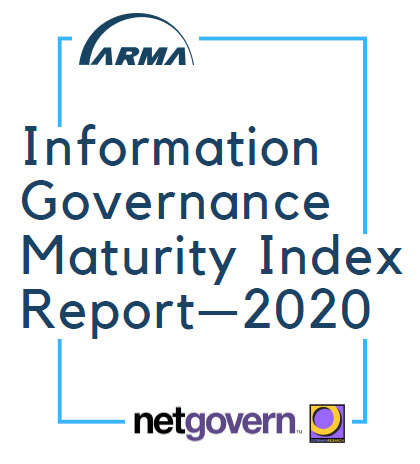ARMA IG Survey Falls Short
NetGovern used to be called NetMail, and most of their business originated from supporting email for Novell NetWare. The survey was conducted with the assistance of Mike Osterman of Osterman Research, a respected source which specializes in writing white papers for software vendors.
The presentation of the results during a Zoom webinar was executed well, led by ARMA’s Nick Inglis, executive Director of Content and Programming, and Ann Snyder, Manager of Content Development. But the approach, design, and results of the survey turned out to be self-serving for ARMA and NetGovern, and not the ARMA community or broader IG market. Those on the low-end of the maturity scale are potential sales prospects for NetGovern, and training prospects for ARMA.
Essentially, the survey was designed to measure the maturity of items that tie into ARMA’s new and unproven IG Implementation Model. The 2020 report states additional ARMA training classes will be developed, (“… forthcoming educational and training materials [from ARMA] will target the seven areas of the IGIM and the elements within each.”)
IG World believes the 2021 IG Maturity Index Report could be improved by the adding more questions, and taking an approach which addresses the following issues with the 2020 survey:
- There was little for the IG community to gain in terms of insights. No questions on who the executive sponsors are in successful IG programs; no questions about major barriers to IG implementation; none on the specific IG subprograms being implemented, and their relative successes; none on the business case for IG programs; no information on data monetization or other tangible benefits derived from IG programs—the answers to these questions would have been helpful to fostering the development of IG programs, and to the IG community as a whole;
- The largest segment studied – by far – was government. Fully 27.4% of respondents work in government, whereas the next responding segments were Financial Services (10.1%) followed by Legal (7.3%), Manufacturing (6.9%), Utilities (6.8%), and Professional Services (6.5%). So, the number of government respondents was three or four times the number of respondents from key segments of the commercial economy, which presents a skewed view. No data was provided on the location of the respondents, and important factors such as IG programs are required for Australian governmental agencies, and the National Health Service in the UK, were not considered or reported. And important sectors like Healthcare and Pharmaceuticals only made up 3.5% and 2.2% of the respondents;
- Fully 46.3% of the respondents were organizations with 1000 or less employees. The most active and successful IG programs are in larger organizations that are highly regulated, like those in financial services, utilities, energy, and pharma, so the results are skewed. Of note is that the sponsor, NetGovern, targets small and mid-market companies in marketing efforts. Also, no distinction was made for those with 1000+ employees, that is, companies with 100,000 employees were lumped in with those with 1001 employees. It is clear that these are very different segments, and they should be broken out;
- The job function of the largest number of respondents was Records Management, at 43.6% (and you could add 11.2% who view their jobs as “Information Management”). Yet, based on previous industry research, the most typical leaders of IG programs are General Counsel, although the Legal function made up only 2.9% of the survey group. The very important area of Privacy was almost ignored, as only .4% of the respondents came from that job function;
- Vendor responses were collected but excluded. Instead of reporting on the Tech segment, these responses were discarded. Certainly, other software companies are not sales targets for NetGovern, so why analyze them?
- The results in each category measured followed a basic bell curve, which seems a little suspect when you look at the numbers, as there was little variability. Did the respondents mostly just check the “3” as they were busy at the ARMA conference and wanted to pick up the free lunch that was offered for taking the survey? On all but one measure, respondents ranked their IG program a “3” (out of 5) at between 31.1% and 34.6%. The percentage of respondents that ranked their program a “3” was: Authorities 32%; Supports 31.1%; Processes 34.6%; Capabilities 33.6.1%; Structures 32.1%; Infrastructure 32.0%; Steering Committee 28.7%; Overall IG Maturity 31.8%.
So ARMA gets an “A” for taking some initiative, but a C- on the results of their effort. [/glossary_exclude]
recent posts
You may already have a formal Data Governance program in [...]

